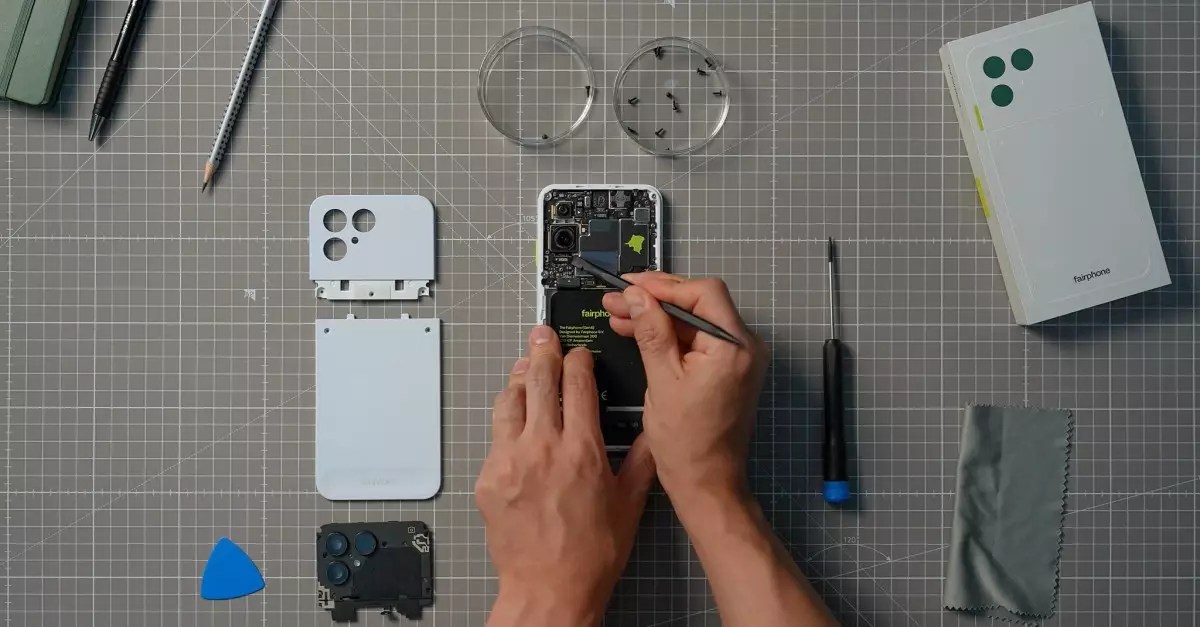In an era where sleek design often takes precedence over longevity, the Fairphone 6 emerges as a beacon of sustainability and user empowerment. Its consistent top-tier performance in iFixit’s teardown tests underscores a revolutionary approach to manufacturing—one that prioritizes modularity, ease of repair, and environmental responsibility. Unlike typical smartphones that discourage user repairs with glued components and proprietary parts, Fairphone consciously dismantles these barriers, enabling consumers to extend their device’s lifespan effectively. This strategic focus not only reduces electronic waste significantly but also challenges the conventional narrative that consumers must replace rather than repair.
The Fairphone 6’s design exemplifies thoughtful engineering. Despite reducing overall size and thickness compared to previous models, it maintains the hallmark repairability that has become its signature. The reduction in complexity, with only seven screws and a straightforward tool (a T5 Torx screwdriver) required to access vital components like the battery, exemplifies how simplicity can be harmonious with advanced technology. The company’s decision to include only minimal glue—confined mainly to the mainboard—further accentuates this deliberate balance between durability and repairability. It reveals a philosophy that repairability should not come at the expense of device integrity but should instead be integral to its design.
Performance Versus Principles: Sacrificing Specs for Sustainability
Fairphone’s commitment to repairability and sustainability prompts a critical question: does this come at a cost to performance? The answer lies in the trade-offs Product aficionados may grit their teeth at. The Fairphone 6’s camera setup is modest at best, and its Qualcomm Snapdragon 7S Gen 3 processor lacks the raw power favored by tech enthusiasts seeking cutting-edge performance. Furthermore, its USB-C port operates on a sluggish USB 2.0 standard, a noteworthy downside for users demanding rapid data transfer or fast charging.
While this might seem like a compromise, it is a conscious trade-off that prioritizes user-repair capability and longevity over fleeting specifications. The impressive 6.3-inch LTPO OLED display, with its adaptable refresh rate of 10-120Hz, ensures that visual quality remains competitive, enhancing user experience without sacrificing the device’s core principles. Ultimately, the Fairphone 6 recognizes that durability, repairability, and environmental sustainability should be integral, even if it means stepping away from the latest flagship performance metrics. It positions itself as a device for users who value transparency, ethical manufacturing, and a longer-lasting product over fleeting technological supremacy.
Commitment to Longevity: How Fairphone Reinvents Support
One of the most compelling aspects of the Fairphone 6 is its ambitious long-term support strategy. Fairphone’s pledge of seven years of Android OS updates and eight years of security patches marks a stark departure from the industry norm, where support periods often lapse after a mere couple of years. This extended support frame embodies a shift towards responsible consumption, reducing e-waste and encouraging consumers to repair rather than discard.
The company also offers a five-year warranty, which is unusual for smartphones, coupled with a customer-centric loyalty program that rewards users for maintaining and repairing their devices. This ecosystem not only incentivizes longevity but underscores a paradigm that views devices as ongoing relationships rather than disposable commodities. By making replacement parts readily available through partnerships with iFixit and offering modular accessories, Fairphone empowers users to customize, repair, and upgrade their devices effortlessly. This shift towards a more sustainable and community-oriented approach challenges established industry practices and signifies a bold vision of a circular economy in electronics.
Pricing and Market Position: A Conscious Investment
The pricing of the Fairphone 6 reflects a strategic stance—costly compared to mainstream smartphones but justified through its repairability, longevity, and ethical manufacturing. Priced at approximately €599 ($705) in Europe and $899 in the United States, the device is positioned as a premium product aimed at environmentally conscious consumers who are willing to invest in sustainability. Its availability through specialized retailers and its exclusivity in regions like the US—where it ships with Murena’s de-Googled /e/OS—highlight its niche appeal.
This price point, coupled with the device’s durability and software longevity, positions the Fairphone 6 less as a fleeting consumer gadget and more as an investment in a sustainable future. It challenges buyers to reconsider their relationship with technology, emphasizing quality and repairability over the bells and whistles driven by Moore’s Law. While it may not match flagship specs, it offers a compelling alternative for those who value ethics, community support, and environmental impact equally with their technological needs.
In a world awash with disposable gadgets, the Fairphone 6 boldly redefines what a smartphone can be—more than just a portable tech device, but a statement of values, responsibility, and resilience. Its continued success and unwavering focus on repairability serve as proof that technology can be both innovative and sustainable, fostering a future where longevity and ethical design take center stage.


Leave a Reply